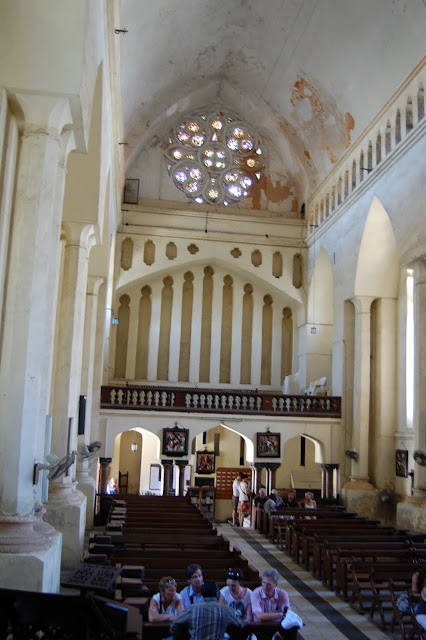Caravans started out from Bagamoyo on the mainland coast, travelling as much as 1,000 miles on foot as far as Lake Tanganyika, buying slaves from local rulers on the way, or, more cheaply, simply capturing them. The slaves were chained together and used to carried ivory back to Bagamoyo. The name Bagamoyo means 'lay down your heart;' because it was here that slaves would abandon hope of freedom.
Slaves who survived the long trek from the interior were crammed into dhows bound for Zanzibar, and paraded for sale like cattle in the Slave Market.
All of the main racial groups were involved in the slave trade in some way or other. Europeans used slaves in their plantations in the Indian Ocean islands, Arabs were the main traders, and African rulers sold prisoners taken in battle. Being sold into slavery was not a prisoner's worst fate - if a prolonged conflict led to a glut, the Doe tribe north of Bagamoyo had the rather gruesome habit of eating 'excess supplies'.
Sultan Barghash was forced in 1873, under the threat of a British naval bombardment, to sign an edict which made the sea-borne slave trade illegal, and the slave market in Zanzibar was closed, with the Cathedral Church of Christ erected on the site. But the trade continued, particularly on the mainland. Slaving was illegal, but it existed openly until Britain took over the mainland following their defeat of the Germans in the First World War. Many former slaves found that their conditions had hardly changed - they were now simply employed as labourers at very low wage rates in the spice plantations.





The oldest Christian Church of its kind in East Africa, the Anglican Cathedral stands on the site of the public slave market, on the eastern side of Stone Town. It was constructed by the Universities Mission in Central Africa (UMCA) in 1877 when the slave trade was abolished. The Cathedral is very interesting inside because it was built with so many different points of significance to honor those slaves who suffered. The baptismal fount was built over an old well for the market. The aisle of the church has two rows of stone tiles in order to signify the trenches that were built along the caravan routes of the slave trade to dispose of the bodies that were weak or already deceased. Near the altar is a small red circle to mark the spot the old whipping post used to stand. Near the front of the church is also a small cross that is believed to be taken from the tree that Livingstone died beneath in Zambia.
The Cathedral is built on the site of a former slave market. The church's altar was once the location of the whipping post. Zanzibar was once the awful hub of slavers selling people into captivity. Steps in the building led down to a dank basement with low-ceilinged stone rooms hung with chains where slaves were kept in horrible crowded conditions before being sold. Up to seventy or so were jammed into a room where twenty could not stand comfortably. It was not thought important if some of the captured people died because it was believed that the surviviors would be the fittest and most valuable for sale anyway.
Near the church on a small lawn was a sculture set into the ground to commemorate the memory of the slaves: five human figures carved in stone and chained at the neck.
The altar is built, somewhat incongruously, directly over the site of the Slave Whipping Post, which was, in reality, a tree.
A memorial to the slave trade, Anglican Church, Stone Town
It’s important to realize that Zanzibar’s present-day existence as an island paradise exists in spite of a very dark past. Zanzibar’s key strategic location–just off the coast of East Africa, and on the shipping route between Europe, India and the Middle East–meant that it grew up as a trading port for all sorts of goods. It goes without saying that the most horrific trade that was played out in Zanzibar was that of slaves.
Here stands the sombre monument to the memory of the countless number of slaves who passed through the islands’ markets. The life-like stone statues of male and female slaves, attached with iron shackles and chains, stand in a pit symbolising not only their inhumane incarceration but also depth of their despair.
The slave market chambers, by candlelight as little natural light exists
Indeed, before slavery was banned (and even for some time after) Zanzibar was of paramount importance to the lucrative and enormous slave trade that existed. Arab slavers hacked their way from the coast of today’s Tanzania into the African interior, as far west as the Congo, along what were to become well-worn jungle footpaths. The slavers traded, bribed chiefs, pillaged and kidnapped to satisfy the high demand for slaves all over the world. The doomed villagers were then marched back out along the footpaths, often to their death, until they reached the coast, where they would be crammed into ship holds bound for the slave markets in Stone Town.
Each cell was used to house up to 70 slaves for a night or two after they were sent over from the mainland and before they would be sent overseas. The cell consists of a several small vents with a deep channel in the middle of it. The channel was built to allow the tide to flow in to clean out the sewage that would collect from the people imprisoned there. It is horrendous to think of the condition of these cells over 100 years ago.















































No comments:
Post a Comment